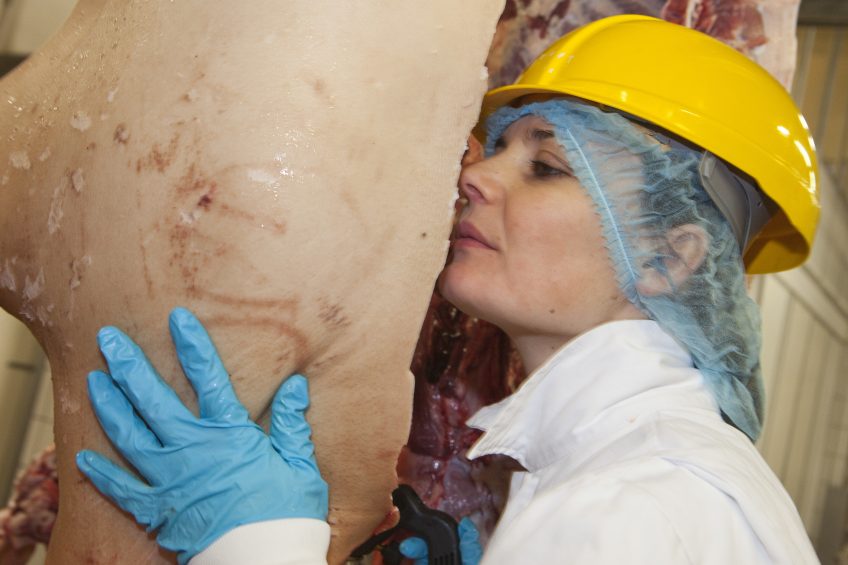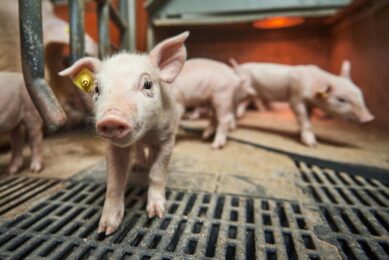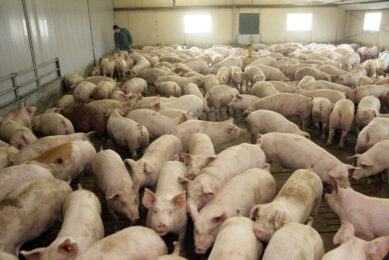The right terminal sire can reduce tainted pig carcasses

The German artificial insemination organisation GFS is making a distinction amongst boars looking at the risk of spreading boar taint to their offspring.
It is possible to finish boars with a reduced risk for boar taint, when applying a terminal sire from artificial insemination organisation GFS. Earlier this month, board member Meike Friedrichs presented the organisation’s so-called Strat-E-Ger programme. This is short for ‘strategic boar choice against taint’.
Testing every young boar
For several months now, the organisation has been testing every young boar in the quarantine pig houses, for the degree as to which they convey boar taint to their offspring. Scientists do so by taking a little bit of young boars’ neck tissue and have that tested in a laboratory for taint risk.
This test is being done using a human nose, after heating. In addition, looking at taint risk, the genetic potential of the young boars is being determined. A calculation is being made on the basis of both the genetic potential as well as the neck tissue test – together the outcome shows the taint risk with the offspring. Accuracy is very close to 100%.
300 boars have been tested
In the meantime, at least 300 young boars have been tested on the amount of boar taint they convey to their offspring. Every month, about 100 new boars are being admitted into the GFS pig houses.
This means, that within 2 years, all boars within the organisation will be tested. In total, there are about 2,000 of them.
Sow breeders can see boar taint transmission
Through the GFS website or boar app, a sow breeder can see the level of boar taint hereditary transmission of boar taint. GFS will classify these boars. The results of the first 32 tested terminal sires are in Table 1. As it turns out, the offspring of the 25% best boars (lowest hereditary levels of boar taint) have hardly any offspring of which the meat stinks after heating.
The classification of offspring of the 25% worst performing terminal sires is clearly different. Here a larger amount of boar carcasses can be found towards the right side of the table – more animals in the danger zone or intact boars that actually are tainted.
Value for slaughterhouses and pig producers
For slaughterhouses as well as pig producers, the breeding value for taint is interesting, Friedrichs noted. A slaughterhouse will have to reduce the value of fewer carcasses for reasons of tainted meat. For pork producers, the advantage is that carcasses from his pigs will not as often be classified as inferior, resulting in a reduction of the price paid.
As a result, the German meatpacker Westfleisch is starting with a trial with GFS’ taint-free terminal sires. The meatpacker will ask its contract finishing farms that do not castrate, to use semen from GFS terminal sires selected for a reduced taint reduction. The meatpacker thus hopes to find out whether this will lead to significantly fewer tainted carcasses.
Available for every pork producer
The ‘taint-free’ terminal sires are available for every pork producer involved in finishing boars, and who happens to be looking for a solution to supply fewer tainted pigs to the slaughterhouse. As soon as all terminal sires have been tested and classified, also taint risk will be figured out of all breeding boars.
Together with various research partners, GFS did research to non-castration as well as the risk to tainted carcasses. The conclusion is hopeful: through breeding and selection of terminal sires, the risk for tainted carcasses can be almost reduced to zero. Especially for androstenone, the hereditability is high, i.e. 64%. The other component of boar taint, skatole, has a lower hereditability, i.e. 48%.
All in all, it looks like there is a lot of room to reduce the risk for boar taint through breeding.
Join 18,000+ subscribers
Subscribe to our newsletter to stay updated about all the need-to-know content in the pigsector, three times a week. Beheer
Beheer










 WP Admin
WP Admin  Bewerk bericht
Bewerk bericht